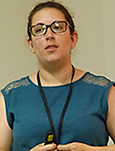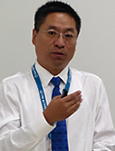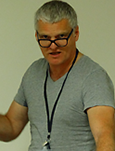
 This presentation discusses the Olympic values that define the pedagogical principles of the Programa Segundo Tempo (PST). Devised by the Ministério do Esporte (ME), it functions as an important tool of Olympic education in Brazil. The educational sports offered by the PST aims to democratize access to the practice and culture of sport in order to stimulate the development of children and adolescents, as a factor of both citizenship formation and general improvements in the quality of life, primarily in areas of social vulnerability. The PST has been offered to municipalities and/or states through various agreements made over the past two years.
This presentation discusses the Olympic values that define the pedagogical principles of the Programa Segundo Tempo (PST). Devised by the Ministério do Esporte (ME), it functions as an important tool of Olympic education in Brazil. The educational sports offered by the PST aims to democratize access to the practice and culture of sport in order to stimulate the development of children and adolescents, as a factor of both citizenship formation and general improvements in the quality of life, primarily in areas of social vulnerability. The PST has been offered to municipalities and/or states through various agreements made over the past two years.
In 2007, the Sports Ministry through its National Educational Sport Secretariat (SNELIS), signed an agreement with the Universidade Federal do Rio Grande do Sul, in order to structure a sport educational proposal, and to apply it to the PST, as well as to maintain a process of continuing education for all professionals involved in the program. The program was structured to systematically track the development of initiatives in the PST cores, throughout the country. The proposal focused on the core principles of participation, torelance, adversity, fair play, enjoyment, mental well-being, interaction, social inclusion and the exercise of citizenship—most, if not all, of these are in line with the principles proposed by Olympic Education. This educational structure is the basis for the training of Physical Education teachers who are the Core and Pedagogical Coordinators. Their educational output is available to the entire population, consisting of seventeen books with over 180,000 copies distributed throughout the country. The entire material is also available online through the ME website. So far we have trained over 29,000 teachers in on-location courses. Over the past two years, we have also introduced distance education training combined with on-location segments. In addition, the project follows up on-location 20% of all agreements of all groups who develop the PST in the country.
To secure continuous improvements of organizational structures, the program maintains a process of pedagogical and administrative evaluation that are supported by the ME and SNELIS according to their weaknesses and strengths. In order to make advance in the issue of social inclusion a new evaluative action is being proposed and should be applied from 2016 on. Therefore, this Program is meant to be a legacy of the Olympic Games 2016 in Brazil.
 Mega-event legacies in areas such as infrastructure (e.g. Searle, 2002), economic impact (e.g. Kasimati & Dawson, 2009), sport participation (e.g. Girginov & Hills, 2008), and social outcomes (e.g. Minnaert, 2012) have been extensively examined, to date however, little research has focused directly on event management-related legacies. The 1996 Games in Atlanta (and the years leading up to the Games) represented a turning point in the commercial orientation of the Games from various perspectives. While arguably a commercial success, the Games have been heavily criticized for their overly commercial nature (Pound, 2004). As a result it can be suggested that any perceived paradox between Olympic values and commercialism would have been emphasized in the minds of consumers. Also during this time, the IOC undertook a brand audit, suggesting organizers (i.e. IOC, Organizing Committees) were developing an understanding of the value of the Olympic Games as a brand and therefore an increasing comprehension of the importance of strategically growing, managing, and protecting their brand. Furthermore, with the TOP program in its third cycle, both sponsors and ambushers had the experience to recognize the power and pitfalls of Olympic sponsorship. Moreover, with the Games taking place in sponsor-rich United States for the first time since the introduction of TOP, there was an abundance of sponsor and ambusher opportunity. With these issues in mind the objective of this research is to identify long-term marketing legacies of the 1996 Olympic Games. More specifically, it seeks to understand legacies related to marketing expectations during the bidding process, marketing capacity, ambush marketing practices and management, consumer perceptions, and brand management.
Mega-event legacies in areas such as infrastructure (e.g. Searle, 2002), economic impact (e.g. Kasimati & Dawson, 2009), sport participation (e.g. Girginov & Hills, 2008), and social outcomes (e.g. Minnaert, 2012) have been extensively examined, to date however, little research has focused directly on event management-related legacies. The 1996 Games in Atlanta (and the years leading up to the Games) represented a turning point in the commercial orientation of the Games from various perspectives. While arguably a commercial success, the Games have been heavily criticized for their overly commercial nature (Pound, 2004). As a result it can be suggested that any perceived paradox between Olympic values and commercialism would have been emphasized in the minds of consumers. Also during this time, the IOC undertook a brand audit, suggesting organizers (i.e. IOC, Organizing Committees) were developing an understanding of the value of the Olympic Games as a brand and therefore an increasing comprehension of the importance of strategically growing, managing, and protecting their brand. Furthermore, with the TOP program in its third cycle, both sponsors and ambushers had the experience to recognize the power and pitfalls of Olympic sponsorship. Moreover, with the Games taking place in sponsor-rich United States for the first time since the introduction of TOP, there was an abundance of sponsor and ambusher opportunity. With these issues in mind the objective of this research is to identify long-term marketing legacies of the 1996 Olympic Games. More specifically, it seeks to understand legacies related to marketing expectations during the bidding process, marketing capacity, ambush marketing practices and management, consumer perceptions, and brand management.
 This research employs a qualitative case design (Yin, 2013). The case is being built from a detailed document analysis using historical and contemporary sources. Types of data include: official reports, bid documents, personal communications and memoirs, meeting minutes, hosting manuals, and newspaper clippings, among others. Data has been collected from various sources including the Olympic Studies Centre and Archives, the Kenan Research Center at the Atlanta History Center, and the Special Collections Library at the University of Georgia. Data analysis will consist of content analysis using ATLAS.ti qualitative analysis software. As data is collected and created, it is analyzed following strategies described by Miles,Huberman and Saldana (2014) and Yin (2013). These approaches aid researchers in identifying recurring themes from the data. Following the identification and classification of initial codes, researchers will undertake axial coding to provide a deeper understanding of the coded data (Corley & Gioia, 2004). This will facilitate the grouping information from initial coding into higher-order themes.
This research employs a qualitative case design (Yin, 2013). The case is being built from a detailed document analysis using historical and contemporary sources. Types of data include: official reports, bid documents, personal communications and memoirs, meeting minutes, hosting manuals, and newspaper clippings, among others. Data has been collected from various sources including the Olympic Studies Centre and Archives, the Kenan Research Center at the Atlanta History Center, and the Special Collections Library at the University of Georgia. Data analysis will consist of content analysis using ATLAS.ti qualitative analysis software. As data is collected and created, it is analyzed following strategies described by Miles,Huberman and Saldana (2014) and Yin (2013). These approaches aid researchers in identifying recurring themes from the data. Following the identification and classification of initial codes, researchers will undertake axial coding to provide a deeper understanding of the coded data (Corley & Gioia, 2004). This will facilitate the grouping information from initial coding into higher-order themes.
This research aims to understand how Olympic marketing can be impacted by the input, events, and circumstances of individual Games. Furthermore, it seeks to expand knowledge and understanding of event management-related legacies. This will aid in the planning and execution of such legacies and hopefully encourage a more balanced and rational approach to the growth of marketing knowledge and capacity within the Olympics specifically, and within the appropriate scope of such generalizations, mega-events more broadly.
 After the inaugural 2010 Youth Olympic Games (YOG) in Singapore, the 2nd summer YOG was successfully held in Nanjing, China in 2014. China also hosted a spectacular summer Olympic Games in Beijing 2008. There were a total of 204 National Olympic Committees (NOCs) that sent athletes to both Beijing Olympic Games and Nanjing YOG. Both events were established by the International Olympic Committee (IOC), however, compared with the Beijing Olympic Games, the Nanjing YOG was in a much smaller scale and did not receive as much attention from the world. Is the YOG just a miniature of the regular Olympic Games? What is the YOG’s unique value and how it should be promoted? As a coordinator of a global service learning program for the Beijing Organizing Committee for the Olympic Games, I also served as an Expert for the Culture and Education Program (CEP) of the Nanjing YOG. This paper is based on official reports and observations of both Beijing Olympic Games and Nanjing YOG from the educational point of view.
After the inaugural 2010 Youth Olympic Games (YOG) in Singapore, the 2nd summer YOG was successfully held in Nanjing, China in 2014. China also hosted a spectacular summer Olympic Games in Beijing 2008. There were a total of 204 National Olympic Committees (NOCs) that sent athletes to both Beijing Olympic Games and Nanjing YOG. Both events were established by the International Olympic Committee (IOC), however, compared with the Beijing Olympic Games, the Nanjing YOG was in a much smaller scale and did not receive as much attention from the world. Is the YOG just a miniature of the regular Olympic Games? What is the YOG’s unique value and how it should be promoted? As a coordinator of a global service learning program for the Beijing Organizing Committee for the Olympic Games, I also served as an Expert for the Culture and Education Program (CEP) of the Nanjing YOG. This paper is based on official reports and observations of both Beijing Olympic Games and Nanjing YOG from the educational point of view.
Initiated by former IOC President Jacques Rogge, the vision of the YOG is to inspire young generation to participate in sport and to learn about Olympism and the Olympic values. In addition to participate in sport competition, an equally import part of YOG is for the young athletes to participate in the Culture and Education Program (CEP) and learn about social responsibility, healthy lifestyle and mutual respect to different cultures, a unique spirit born with YOG DNA.
For the Nanjing YOG, 3808 athletes stayed together for a full 12 days and take part in 4837 CEP events including Discovery Activity, Chat with Champions, World Cultural Village etc. created especially for them. A total participation counted to over 1,230,000 times. Different from Beijing where “Faster, Higher, Stronger” was emphasized, healthy behavior, participation and collaboration were promoted in Nanjing. The CEP program activities were well participated and appreciated by the young and talented people from all over the world. Such mega event like YOG is a timely call to address the challenging issues including the decline in physical activity and increase in obesity among young people, as well as global issues related diversity and world peace. The Nanjing YOG Organizing Committee also co-hosted the World Youth Forum on Sport, Culture and Peace with the United Nations Educational, Scientific and Cultural Organization (UNESCO). The IOC and UNESCO has partnered to urge governments and educational planners to invest in the quantity and quality of physical education across the world. YOG is a great platform for educating our young generation and be prepared as future responsible global citizens. From Beijing’s “One World, One Dream” to Nanjing’s “Share the Games, Share Our Dreams”, YOG is bringing the original concept of Olympic Games. It is critically important for both IOC and educators to seize opportunities and create transformative learning experiences for more young generations in the future, and make the YOG a sustainable event.
 The Beijing and Zhangjiakou joint bid for the 24th Olympic Winter Games is a major strategic decision made by the CPC Central Committee and the State Council. Promotion of ice and snow sports and the development of mass ice and snow sports are the core purpose of the two cities hosting the Winter Olympics. In this context, this study investigated the perceived popularity of ice and snow sports among the population of Beijing.
The Beijing and Zhangjiakou joint bid for the 24th Olympic Winter Games is a major strategic decision made by the CPC Central Committee and the State Council. Promotion of ice and snow sports and the development of mass ice and snow sports are the core purpose of the two cities hosting the Winter Olympics. In this context, this study investigated the perceived popularity of ice and snow sports among the population of Beijing.
The Humanistic Olympics Studies Centre completed an empirical survey, with a total of 4,096 valid questionnaires returned. The survey determined that in the wake of the 2008 Summer Olympic Games, Beijing's hosting of the Winter Olympics has very strong public support, but several problems remain and require improvements, in particular: the low public profile of mass ice and snow sports; low frequency and levels of participation in ice and snow sports that do not offer grounds for optimism; and lastly, improvements are required to sports facilities, sports scientific research support, professional talent identification and training, and general media mobilization.
Through in-depth discussion and research, in this paper, we propose a new concept of social mobilization, principles and mechanisms, to remedy these issues. Optimization of ice and snow sport projects construction, and of software and hardware development are some of the promising avenues for investigation.
 This paper examines the financing and marketing of the Los Angeles Olympics. After the financial disaster of the 1976 Montreal Games, and the troubled Moscow games it appeared that the Summer Olympics may have become too expensive and complicated for cities to host. Peter Ueberroth became the chair of the Los Angeles organizing committee, and the group took a completely different approach in financing the games.
This paper examines the financing and marketing of the Los Angeles Olympics. After the financial disaster of the 1976 Montreal Games, and the troubled Moscow games it appeared that the Summer Olympics may have become too expensive and complicated for cities to host. Peter Ueberroth became the chair of the Los Angeles organizing committee, and the group took a completely different approach in financing the games.
The Los Angeles Games were the first privately financed Olympics, and resulted in a profit of $250 million that was used to set up a foundation to fund future youth sporting activities in California. Additionally, the committee utilized existing venues that were refurbished, and found existing housing to reduce costs. To fund the games, corporate sponsorships were sold, products endorsed, and television and media revenues used. The LA games, of course, encountered a major problem with the Soviet Union and it client states boycotted the games. In part, this was retaliation for the 1980 boycott of the Moscow games. Nonetheless, the Games were a huge success in the US, buoyed by an inflated medal count that was relished by a nationalistic American audience. The LA games have also drawn criticism for the “selling” of the Olympic movement and the crass commercialism of those games.
For his exceptional organizing skills, Ueberroth was named Time’s Man of the Year for 1984 and was appointed commissioner of Major League Baseball
Evidence and Significance: This paper will utilize research in the publications of the period, particularly the Los Angeles Times, and with interviews and correspondence with Peter Ueberroth. It will also compare the finances of the 1984 Games to other summer Olympics of the era. It will assess the impact of the 1984 Games in changing the financing and marketing of future Olympics, for better and for worse.
 The purpose of this paper is a consideration of the criticalcess factors that were involved in winning the 2012 Olympic and Paralympic Games for London. This paper looks at how London won its bid for the 2012 Olympic and Paralympic Games. The analysis draws on a number of documents, texts and primary data collected including three interviews; with Sir Craig Reedie, former Chair of the British Olympic Association (BOA) and an International Olympic Committee Executive Group member, Mike Lee, former Director of Communications and Public Affairs for the London bid and Richard Caborn, former Minister of Sport in the UK Government at the time of the bid.
The purpose of this paper is a consideration of the criticalcess factors that were involved in winning the 2012 Olympic and Paralympic Games for London. This paper looks at how London won its bid for the 2012 Olympic and Paralympic Games. The analysis draws on a number of documents, texts and primary data collected including three interviews; with Sir Craig Reedie, former Chair of the British Olympic Association (BOA) and an International Olympic Committee Executive Group member, Mike Lee, former Director of Communications and Public Affairs for the London bid and Richard Caborn, former Minister of Sport in the UK Government at the time of the bid.
Olympic Games bids and their environment are shrouded in mystery and the London bid remains an enigma to this day. How did the city beat Paris, indeed how did it come to win from seemingly third place in that race? With the media hotly tipping Madrid and Paris in particular, the thoughts at the time were that the influential presentation by the London team in Singapore was the critical factor that won the day.
This paper provides some insight into this question using revealing in-depth interviews with key players. It shows that while the presentation to IOC members was important and delivered well, it was the culmination of many years work and strong decision making that won this bid. As Sir Craig Reedie says, “You could never win the Games by a presentation but you could lose one with a bad presentation” (Masterman, 2013). There were a number of critical success factors, the personnel involved unified by a team ethic, a vision that put sport at its heart, clearly defined competitive differential that was communicated well, and last but by no means least, a number of key personalities with incomparable work ethic and sense of winning knowhow.
The strategy that was devised for the days spent in the bid event city Singapore provided the opportunity to bring this altogether. The London team got there early and camped in another hotel but had a clear plan to work the main event venue, carefully deploying key players, including Tony and Cherie Blair. This followed several years of lobbying by a very successful trio of Sir Keith Mills, the bid's chief executive, Sir Craig Reedie and Lord Sebastian Coe. A planned, rehearsed and inclusive approach via all of these key factors was how London won.
 The role of sports mega events for the economic and political life of nations has increased significantly. In this paper, we investigate the political business cycle and its place in the Olympic movement. Special attention is paid to the Olympic business cycle, its unity and difference from the classical business cycle and political business cycle.
The role of sports mega events for the economic and political life of nations has increased significantly. In this paper, we investigate the political business cycle and its place in the Olympic movement. Special attention is paid to the Olympic business cycle, its unity and difference from the classical business cycle and political business cycle.
The following methods and instruments were used: formal economic-mathematical models, comparative analysis, content-analysis, multi-factor analysis, public choice methods.
The decision-making process of Olympic capital selection has several features at different stages. The International Olympic Committee has developed a special system of Applicants and Candidate Cities estimation. The Candidature Acceptance Procedure included elven indicators during the Bid procedure of 2009, when Rio de Janeiro was selected. All these indicators are summarized in a Final Matrix, which is used as a basis for candidate cities definition. The example of Rio is used in order to describe these indicators, detect their advantages and disadvantages, and analyze their importance for the determination of the final score. International sport analytical agencies (“Games Bids” and “Around the Rings”) also have their own ratings built on the indicators which influence the final indexes and shape public opinion.
Special attention is paid to the voting procedure in the final part of the decision. The analysis showed the preferences of IOC members in selecting the capitals of the Olympic Games applicant cities, and also examines predictors of informal relations in the decision-making process. — Three basic models of administration and financing can be applied to any Olympic Games:
They were divided by the value of public and private funding with regard to incomes and expenditures. The cost-benefit analysis allows us to define when expenditures are greatest, and when revenues are highest during the Olympic business cycle. The mechanisms of administration play an important role during the Olympic business cycle. High-quality, effective management and planning makes it possible to achieve profitable and successful Olympic Games. Special attention is paid to the structure of Rio de Janeiro 2016 expenditures, examining: general infrastructure, Olympic venues, accommodation, administration, security, environmental policies, etc.
Olympic Games have a great impact on the host country’s economy. This influence is investigated by focussing on the major macroeconomic factors. A dependence exists between the chosen model of administration and the financing of the Olympic Games and economy and sport development in SR and LR. The impact on Olympics host country economies can be characterized by examining the general factors: production growth; employment growth; the growth of tourism; the expansion of the banking sector; value of taxe revenues; an increase in effective demand, etc
The paper also systematized international experiences in organizing and hosting the Olympic Games, with special attention given to the preliminary socio-economic results of the Olympic Games of Rio de Janeiro 2016.